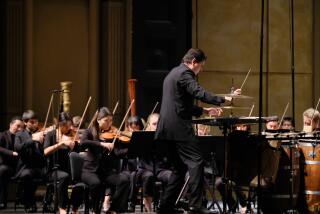Strains of an Unfinished Symphony
- Share via
LONDON — Is it morally defensible to ignore the last wishes of a national hero if there is a chance of re-creating a flash of his genius? Listen to the music. But beware: Sour notes echo from the audience.
As he lay dying of cancer in 1933, Edward W. Elgar, the great English composer, worried about his unfinished Third Symphony. “Don’t let anyone tinker with it. . . . No one could understand,” he told his daughter Clarice and friend W.H. Reed, head of the London Symphony, according to Reed’s written account of the bedside conversation.
Burn it all, Elgar urged.
They didn’t. As a result, Elgar’s last work may premiere here this summer as constructed from his sketches by composer Anthony Payne at the request of the composer’s eight surviving descendants.
“I hope the old chap will rest easy and forgive us,” said Paul Grafton, Elgar’s grandnephew, a spokesman for what he describes as the family’s reluctant decision to violate the composer’s dying wish.
Enter discordant debate, for Elgar is a revered symbol in Britain, the articulate and Romantic musical emblem of the storied, opulent era when the sun never set on the British Empire.
Most Americans of a certain age graduated from something to the strains of Elgar’s “Pomp and Circumstance.” In Britain, though, the celebratory vocal version of that march, “Land of Hope and Glory,” is as moving for many today as “God Save the Queen,” the national anthem. Two symphonies and his “Enigma Variations” are concert favorites.
Trouble began, Grafton says, when Elgar’s daughter and friend published some of his sketches for the Third Symphony in a 1934 British Broadcasting Corp. magazine.
The BBC, which commissioned the symphony at the behest of George Bernard Shaw, may premiere Payne’s work as part of its summer concert series. Copyright on the sketches expires in 2004, Grafton notes, after that the family faces the prospect of a free-for-all among rival composers striving to finish Elgar’s work.
“We thought it would be better to have somebody of Payne’s stature work with the material,” said Grafton. “It will not be the completion of Edward’s Third Symphony, but it should be an interesting piece of music. If anybody betrayed Edward it was his own daughter. We can’t do any worse.”
Not everybody agrees. And, in a dispute that by now embroils the Elgar family, biographers, musicologists, editorial writers and music buffs, neutrality is difficult.
“I’m sitting on the fence, and it’s composed of razor blades. The moral position is quite clear, but I also understand the family’s view that it is better to have some sort of completion by a composer of some reputation than by any unknown outsider,” said Andrew Neill, president of the Elgar Society, which has 1,400 members worldwide, 130 in the United States.
The-Do-Not-Tinker forces count in their score not only those who have moral reservations but also knowledgeable people who believe that Elgar’s material was too sparse and disorganized to be effectively rendered more than a half century later.
E. Wulstan Atkins, Elgar’s godson, exemplifies the depth of feeling. A retired civil engineer, he regales a caller with a prepared statement--500 polished words of remonstrance. “Am I reading too fast?” he inquires politely. Atkins is 92.
Lamenting the “most regrettable and difficult-to-understand decision” to tinker, Atkins says that “Elgar knew that from what he had already written it would be impossible for anyone to complete the work in the way in which he had it in his mind.”
He recalls that, as a young man, he and his father, the organist at Worcester Cathedral for more than 50 years, visited Elgar nearly every Sunday evening.
Over the years, Elgar had played many works in progress for them. But when it came to the Third Symphony, “Elgar played the sketches as he composed them with no indication as to the order in which they would appear in the finished work,” Atkins says. “He was most mysterious. . . . All he did say was that the symphony would be completely different from either of the earlier symphonies, much lighter in texture.”
Critics say Elgar’s Third was essentially unformed, consisting of only 30 orchestrated bars of music and 141 disorderly pages of piano sketches.
“I think Elgar wanted the sketches burned because there is so little material there. There is a thread of first movement exposition and two themes, but not a note of central development,” said Jerrold Northrop Moore, an Elgar biographer.
Elgar worked inductively, small to large, writing the opening exposition and closing recapitulation first and the central development last, Moore noted.
“In this case, the central part of how you get there is lacking. The work could be nothing but Mr. Payne’s symphony on Elgar’s uncompleted themes,” he said.
The pro-tinkerers take a longer view. Among them, the establishment Daily Telegraph notes that when Roman poet Virgil realized 2,000 years ago that death would prematurely end his Aeneid, he also uttered the dramatic words, “Burn it.” Happily no Roman did.
In his London studio, Payne is grappling with Elgar’s legacy in excitement and delight. He has passed the midpoint in the symphony, he said.
“It’s like a jigsaw, the way his mind worked. The shapes are there. It is thrilling to touch them, and to perhaps to see the light,” Payne said.
A composer of note in his own right, Payne has been an Elgar scholar for more than two decades. A BBC documentary that Payne did on Elgar’s Third convinced the family, which had rebuffed many overtures from would-be tinkerers, that he should get the commission.
However it emerges from Payne’s studio, Elgar’s legacy is potentially lucrative, but his family says that everything it earns will go to establish scholarships for composers.
More to Read
The biggest entertainment stories
Get our big stories about Hollywood, film, television, music, arts, culture and more right in your inbox as soon as they publish.
You may occasionally receive promotional content from the Los Angeles Times.










